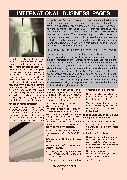INTERNATIONAL BUSINESS PAGES In textile manufacturing, a variety of chemicals are added to give textiles different properties, like dyeing into a specific color or to cre- ate a dirt and water repellent surface of a fabric. Some of the chemi- cals are washed out from the textiles before they reach the consumer, but sometimes there are chemicals left in the textile material when it reaches the consumer. The chemicals are gradually leached out as the products are used and worn out, however there is no guarantee that all chemicals are washed out from the textile. Consequently, it is important to know what chemicals remain in the material before us- ing them as feedstock in new products. About 3500 substances have been identified as relevant for use in textiles. Recycling of textile materials into new products within the same material cat- egory is desired, but textiles for mate- rial recycling can also be utilized as raw material for production of new plas- tics, composite or nonwoven products. One very important issue in material recycling of textile is the question of possible chemical content in the ma- terial and the implications that this may have on the products made from recycled textile. Insufficient knowledge and information about composition and content of textile products for recycling is a challenge and a hurdle in regard to enabling highvalue recycling and to establish trust in recycled feedstock. Mitigating microfiber release Microplastics have proven to be an environmental problem in our oceans. When the microplastics enter animals and plants, hazardous contaminants do too. The reason for the increasing amount of microplastics in the oceanThe mechanical recycling is considered to be as the worst-case sce- nario because this technology does not, and cannot, sort out or filter out any chemicals. In other words, what you introduce into the pro- cess will remain in the product – in this case recycled textile fiber. In a circular economy, we need to retain control of our recycled materi- als and the resulting products, where it is the legislation around the resulting product that must be fulfilled. Again, in a case where re- cycled textile fiber is produced and used as raw material in a gar- ment at 50% recycled content, this is to be considered as the most difficult case when considering legislation around chemical content, as compared to using the recycled fiber in a nonwoven for the auto- motive industry to give an example. is not fully known, but a number of re- ports, including one that was published by RISE and Mistra Future Fashion, clearly show that washing of textiles is one of the contributors. The Minshed project, ending 2021 aims to create knowledge and guide- lines that will help the textile industry to design and create clothes made of synthetic fabrics which do not emit microplastics. The project will also in- vestigate how washing machines are designed and whether they can be equipped with a filter that can reduce the emissions of microplastics. Work continues in the H2020 project HEREWEAR, coordinated by Centex- bel.different prerequisites and needs •Need to be able to guide large vol- umes of materials the right way through the value chain •The solutions we develop must be both environmentally and economi- cally sustainable – circularity must be sustainable Digitization and logistics solutions throughout the value chain •Analysis and certification of mate- rials and prototypes regarding eg durability and toxicity (non-toxic materials) •Production & Mfg. knowledge •Cross-connections between value chains (sustainable substitution be- tween textile/paper/plastic, as well as bridges between value chains and material applicationsInformation need in the textile value chain Important to effectively handle large material volumes •Scaling up recycling techniques is dependent upon a safe and defined material flow•Recycling processes, both me- chanical and chemical, in symbio- sis with existing industry •Sorting for reuse and recycling has•Test & demo facilities NCM-OCTOBER 2021 63
